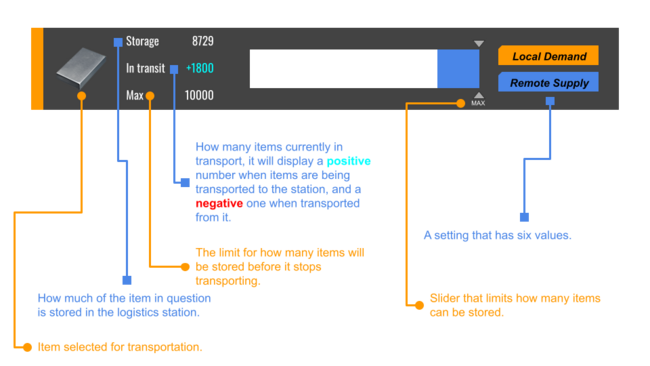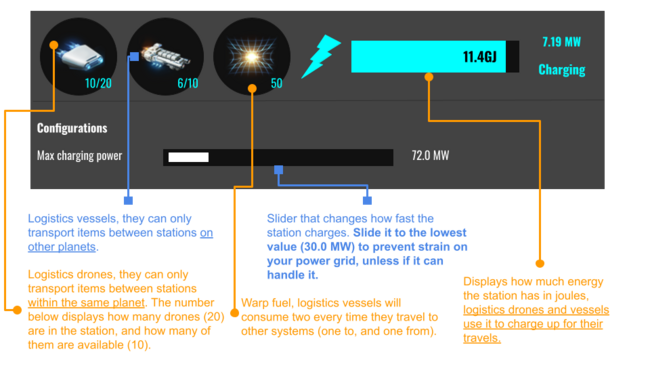imported>76561198426930288 (→Minimum Load: add: if ILS is full it will always send) |
imported>76561198291663882 (Major cleanup) |
||
| Line 1: | Line 1: | ||
{{WIP}} | {{WIP}}'''Logistics Stations''' are large buildings that are used to store and transport much larger quantities of items than [[Logistics Bot|Logistics Bots]] can. Eventually, it is even possible to transport items between planets and even star systems. | ||
== | ==Mechanics== | ||
There are two types of logistics stations | There are two types of logistics stations. The first one the player unlocks is the [[Planetary Logistics Station]]. This station uses [[Logistics Drone|Logistics Drones]] and transports items to other Logistics Stations on the same planet. The second type is the [[Interstellar Logistics Station]], which is a direct upgrade from the Planetary Logistics Station. It retains all the functionality of the Planetary Logistics Station, but it can store and distribute 1 extra type of item, as well as transport items between other planets and star systems using [[Logistics Vessel|Logistics Vessels]]. | ||
The second type is the [[ | Below are illustrations on the basics of how these stations work. | ||
[[File:ExplanationSVG.svg|650px|center]] | [[File:ExplanationSVG.svg|650px|center]] | ||
== Examples == | |||
This image below is an example of how a planetary logistics line would look like. In this example, the Planetary Logistics Station on the left is supplying [[Iron_Ingot|Iron Ingots]] to the one on the right. | |||
[[File:Local_transportation_edit3.png|alt=|center|430x430px]] | |||
[[File: | |||
In this second example, the Planetary Logistics Stations are replaced with Interstellar Logistics Stations. However, their functionality is the same, since neither Interstellar Logistics station is remotely supplying or demanding items. But compared to planetary stations, interstellar ones can also transport items from the entire solar system, and even beyond, but [[Logistics_Vessel|logistics vessels]] are required for them to function. | |||
[[File:Local_interstellar_transport2.png|alt=|center|430x430px]] | |||
In this example, the Interstellar Logistics Stations are instead moving Iron Ingots between planets. Note that Logistics Drones are not sufficient for interplanetary logistics, and instead Logistics Vessels are required. | |||
[[File:Remote_transport2.png|alt=|center|430x430px]] | |||
Finally, here is an example of a system-wide distribution network. On the left planet, one Interstellar Logistics Station is supplying Iron Ingots to the other on the planet, and the other one is supplying them to the other planet. On the right planet, the inverse is happening: one Logistics Station requests Iron Ingots from the other planet, then distributes it to the other Logistics Station on its own planet. | |||
Note that this system of having a centralized station is not necessarily a requirement. It is possible to have multiple Logistics Stations transport items directly to one destination, instead of using a centralized one in the middle. | |||
[[File:Example of transport2.png|650px|center]] | [[File:Example of transport2.png|650px|center]] | ||
<br> | <br> | ||
==Details== | ==Details== | ||
[[File:Infographic3.png|650px]] [[File:Infographic4.png|650px]] | [[File:Infographic3.png|650px]] [[File:Infographic4.png|650px]] | ||
== | ==Planetary Logistics Guide== | ||
Planetary transportation is unlocked with the [[Planetary Logistics System (Tech)|Planetary Logistics System]] technology. To set up a transportation line, at least 2 Planetary Logistics Stations on the same planet are necessary, and at least 1 of those stations must have at least 1 Logistics Drone. | |||
At the station which you wish to supply items from, construct a conveyor belt going into the station carrying the items to distribute. In the station's menu, select the item you wish to supply, and set it to {{Glow|blue|Supply}} mode. This instructs the Logistics Drones to take items from this station and bring them to any other station that {{glow|Demands}} them. | |||
At the station which you wish to transport items to, select the item to receive in the station's menu, but instead set it to {{Glow|Demand}}. This instructs the Logistics Drones to find other stations that are {{Glow|blue|Supplying}} that item and bring the item to this station. To take items out of the station, construct a conveyor belt coming out of it and set the appropriate filter. | |||
In either station (or both), add Logistics Drones. A station's Logistics Drone will move items between that station and another appropriate one. Keep in mind that Logistics Drones will not make multiple stops on a trip; they will fly directly from the source station to the recipient station, without visiting any other stations along the way. | |||
The | Each station can handle up to 4 different types of items. Each of these items can be individually set to {{Glow|blue|Supply}} or {{Glow|Demand}}. The Logistics Drones will carry out their work as quickly as they can. An item can also be set to '''Storage''', which means that Logistics Drones will leave that item alone and will not attempt to bring or take that item. | ||
== Interplanetary and Interstellar Logistics Guide == | |||
Interplanetary transportation is unlocked with the [[Interstellar Logistics System (Tech)|Interstellar Logistics System]] technology. To set up a transportation line, 2 Interstellar Logistics Stations on ''different'' planets are required, and at least 1 of them must have at least 1 Logistics Vessel. | |||
Interstellar Logistics Stations also allow transportation within that same planet and will interface appropriately with Planetary Logistics Stations, so the interface is a little more complex. An Interstellar Logistics Station has several key differences from a Planetary Logistics Station: it can manage 5 items instead of 4, it can have both Logistics Drones and Logistics Vessels, and each item has additional settings ({{Glow|blue|Local Supply}}/{{Glow|Local Demand}} and {{Glow|blue|Remote Supply}}/{{Glow|Remote Demand}}). | |||
The '''Local''' setting determines whether Logistics Drones will transport items between other stations ''on that same planet.'' The '''Remote''' setting determines whether Logistics Vessels will transport items between other Interstellar Logistics Stations ''on'' ''other planets''. | |||
Setting an item to {{Glow|blue|Local Supply}} allows Logistics Drones to bring that item to other logistics stations on that planet that are {{glow|Demanding}} it. Setting it to {{Glow|Local Demand}} has the inverse effect; Logistics Drones will take items from other logistics stations on that planet that are {{Glow|blue|Supplying}} it and bring them back to that station. {{Glow|blue|Remote Supply}} and {{Glow|Remote Demand}} follow the same principles, but deal with stations that are on other planets instead. Setting the item to {{Glow|blue|Remote Supply}} allows Logistics Vessels to take items from that station and bring them to Interstellar Logistics Stations that are {{Glow|Remotely Demanding}} it on other planets. Likewise, setting the item to {{Glow|Remote Demand}} allows Logistics Vessels to bring items to that station from other planets' stations that are {{Glow|blue|Remotely Supplying}} items. | |||
The '''Local''' and '''Remote''' settings will not interfere with each other and can be freely combined. Here is an example illustrating how to combine '''Local''' and '''Remote''' settings for maximum efficiency. Assume the planet '''Cervus 2''' has [[Titanium Ore]], and the planet '''Cervus 3''' has none. There are various Planetary Logistics Stations around Cervus 2 near Titanium veins, and all of them are set to {{Glow|blue|Supply}}. Cervus 2 also has an Interstellar Logistics Station with Titanium Ore set to {{Glow|Local Demand}} and {{Glow|blue|Remote Supply}}. Logistics Drones on Cervus 2 will bring Titanium Ore from all the Planetary Logistics Stations to the Interstellar Logistics Station, because it is set to {{Glow|Local Demand}}. Cervus 3 also has an Interstellar Logistics Station, but it has Titanium Ore set to {{Glow|blue|Local Supply}} and {{Glow|Remote Demand}}. Logistics Vessels will carry the Titanium Ore from Cervus 2 to Cervus 3, because the Cervus 2 station is set to {{Glow|blue|Remote Supply}} and the Cervus 3 station is set to {{Glow|Remote Demand}}. There are also Planetary Logistics Stations on Cervus 3 with Titanium Ore set to {{Glow|Demand}}, so the Logistics Drones on Cervus 3 will carry Titanium Ore to them. In this way, Titanium Ore is gathered from all across Cervus 2, then distributed across Cervus 3. | |||
After researching [[Logistics Carrier Engine (Upgrade)|Logistics Carrier Engine Level 4]], Logistics Vessels can use [[Space Warper|Space Warpers]] to warp long distances. 2 Space Warpers are consumed per trip: one for the outgoing trip, and one for the return trip. The Interstellar Logistics Station has a setting that determines how far a destination must be in order to use the warp; by default this is 12 AU, but can be as low as 0.5 AU or as high as 60 AU. | |||
<Add screenshots and illustations> | <Add screenshots and illustations> | ||
| Line 62: | Line 59: | ||
== Minimum Load == | == Minimum Load == | ||
''' | The '''Minimum Load''' setting dictates how much of an item must be ready to transport before Logistics Drones or Logistics Vessels will make a trip. For example, if the capacity of Logistics Drones is 100 items and the minimum load is 50%, the Logistics Drones will not set out until there are at least 50 items to transport at once. | ||
An important mechanic to keep in mind is that if an item's storage in a logistics station is full, Logistics Drones and Logistics Vessels will ''always'' make trips regardless of the minimum load. For instance, if an item's maximum capacity in the logistics station is set to 100, Logistics Drones and Logistics Vessels will transport that item even if their minimum load is above 100 items (since otherwise, the item cannot be transported at all since it will never meet the minimum load requirement). This is useful to ensure that an item is not over-distributed; for instance, by setting the logistics station's maximum capacity to 100 items, no more than 100 items can ever be sent at once. | |||
Note that because the | Note that because the minimum load is expressed as a percentage, researching higher levels of the [[Logistics Carrier Capacity (Upgrade)|Logistics Carrier Capacity]] technology can cause problems with the quantities of items distributed. For that reason, it's a good idea to assume the endgame maximum vessel capacity of 1000, rather than whatever capacity the vessels currently have. | ||
The minimum load setting only applies to the Logistics Drones and Logistics Vessels that ''belong to that station'', regardless of whether that station is {{Glow|blue|Supplying}} or {{glow|Demanding}}. However, it is possible that both the {{Glow|blue|Supplying}} and {{glow|Demanding}} stations have their own Drones and Vessels. In this case, reducing the minimum load on either side will work; if one station has a lower minimum load than the others, the other stations will honor that setting. However, if only one side of the exchange has Drones or Vessels, the minimum load for that specific side is the one that matters; adjusting the other station's minimum load will not have any effect. | |||
Latest revision as of 07:57, 24 February 2023
Logistics Stations are large buildings that are used to store and transport much larger quantities of items than Logistics Bots can. Eventually, it is even possible to transport items between planets and even star systems.
Mechanics
There are two types of logistics stations. The first one the player unlocks is the Planetary Logistics Station. This station uses Logistics Drones and transports items to other Logistics Stations on the same planet. The second type is the Interstellar Logistics Station, which is a direct upgrade from the Planetary Logistics Station. It retains all the functionality of the Planetary Logistics Station, but it can store and distribute 1 extra type of item, as well as transport items between other planets and star systems using Logistics Vessels.
Below are illustrations on the basics of how these stations work.
Examples
This image below is an example of how a planetary logistics line would look like. In this example, the Planetary Logistics Station on the left is supplying Iron Ingots to the one on the right.
In this second example, the Planetary Logistics Stations are replaced with Interstellar Logistics Stations. However, their functionality is the same, since neither Interstellar Logistics station is remotely supplying or demanding items. But compared to planetary stations, interstellar ones can also transport items from the entire solar system, and even beyond, but logistics vessels are required for them to function.
In this example, the Interstellar Logistics Stations are instead moving Iron Ingots between planets. Note that Logistics Drones are not sufficient for interplanetary logistics, and instead Logistics Vessels are required.
Finally, here is an example of a system-wide distribution network. On the left planet, one Interstellar Logistics Station is supplying Iron Ingots to the other on the planet, and the other one is supplying them to the other planet. On the right planet, the inverse is happening: one Logistics Station requests Iron Ingots from the other planet, then distributes it to the other Logistics Station on its own planet.
Note that this system of having a centralized station is not necessarily a requirement. It is possible to have multiple Logistics Stations transport items directly to one destination, instead of using a centralized one in the middle.
Details
Planetary Logistics Guide
Planetary transportation is unlocked with the Planetary Logistics System technology. To set up a transportation line, at least 2 Planetary Logistics Stations on the same planet are necessary, and at least 1 of those stations must have at least 1 Logistics Drone.
At the station which you wish to supply items from, construct a conveyor belt going into the station carrying the items to distribute. In the station's menu, select the item you wish to supply, and set it to Supply mode. This instructs the Logistics Drones to take items from this station and bring them to any other station that Demands them.
At the station which you wish to transport items to, select the item to receive in the station's menu, but instead set it to Demand. This instructs the Logistics Drones to find other stations that are Supplying that item and bring the item to this station. To take items out of the station, construct a conveyor belt coming out of it and set the appropriate filter.
In either station (or both), add Logistics Drones. A station's Logistics Drone will move items between that station and another appropriate one. Keep in mind that Logistics Drones will not make multiple stops on a trip; they will fly directly from the source station to the recipient station, without visiting any other stations along the way.
Each station can handle up to 4 different types of items. Each of these items can be individually set to Supply or Demand. The Logistics Drones will carry out their work as quickly as they can. An item can also be set to Storage, which means that Logistics Drones will leave that item alone and will not attempt to bring or take that item.
Interplanetary and Interstellar Logistics Guide
Interplanetary transportation is unlocked with the Interstellar Logistics System technology. To set up a transportation line, 2 Interstellar Logistics Stations on different planets are required, and at least 1 of them must have at least 1 Logistics Vessel.
Interstellar Logistics Stations also allow transportation within that same planet and will interface appropriately with Planetary Logistics Stations, so the interface is a little more complex. An Interstellar Logistics Station has several key differences from a Planetary Logistics Station: it can manage 5 items instead of 4, it can have both Logistics Drones and Logistics Vessels, and each item has additional settings (Local Supply/Local Demand and Remote Supply/Remote Demand).
The Local setting determines whether Logistics Drones will transport items between other stations on that same planet. The Remote setting determines whether Logistics Vessels will transport items between other Interstellar Logistics Stations on other planets.
Setting an item to Local Supply allows Logistics Drones to bring that item to other logistics stations on that planet that are Demanding it. Setting it to Local Demand has the inverse effect; Logistics Drones will take items from other logistics stations on that planet that are Supplying it and bring them back to that station. Remote Supply and Remote Demand follow the same principles, but deal with stations that are on other planets instead. Setting the item to Remote Supply allows Logistics Vessels to take items from that station and bring them to Interstellar Logistics Stations that are Remotely Demanding it on other planets. Likewise, setting the item to Remote Demand allows Logistics Vessels to bring items to that station from other planets' stations that are Remotely Supplying items.
The Local and Remote settings will not interfere with each other and can be freely combined. Here is an example illustrating how to combine Local and Remote settings for maximum efficiency. Assume the planet Cervus 2 has Titanium Ore, and the planet Cervus 3 has none. There are various Planetary Logistics Stations around Cervus 2 near Titanium veins, and all of them are set to Supply. Cervus 2 also has an Interstellar Logistics Station with Titanium Ore set to Local Demand and Remote Supply. Logistics Drones on Cervus 2 will bring Titanium Ore from all the Planetary Logistics Stations to the Interstellar Logistics Station, because it is set to Local Demand. Cervus 3 also has an Interstellar Logistics Station, but it has Titanium Ore set to Local Supply and Remote Demand. Logistics Vessels will carry the Titanium Ore from Cervus 2 to Cervus 3, because the Cervus 2 station is set to Remote Supply and the Cervus 3 station is set to Remote Demand. There are also Planetary Logistics Stations on Cervus 3 with Titanium Ore set to Demand, so the Logistics Drones on Cervus 3 will carry Titanium Ore to them. In this way, Titanium Ore is gathered from all across Cervus 2, then distributed across Cervus 3.
After researching Logistics Carrier Engine Level 4, Logistics Vessels can use Space Warpers to warp long distances. 2 Space Warpers are consumed per trip: one for the outgoing trip, and one for the return trip. The Interstellar Logistics Station has a setting that determines how far a destination must be in order to use the warp; by default this is 12 AU, but can be as low as 0.5 AU or as high as 60 AU.
<Add screenshots and illustations>
<Perhaps mention the horribly translated message the assistant gives you>
Minimum Load
The Minimum Load setting dictates how much of an item must be ready to transport before Logistics Drones or Logistics Vessels will make a trip. For example, if the capacity of Logistics Drones is 100 items and the minimum load is 50%, the Logistics Drones will not set out until there are at least 50 items to transport at once.
An important mechanic to keep in mind is that if an item's storage in a logistics station is full, Logistics Drones and Logistics Vessels will always make trips regardless of the minimum load. For instance, if an item's maximum capacity in the logistics station is set to 100, Logistics Drones and Logistics Vessels will transport that item even if their minimum load is above 100 items (since otherwise, the item cannot be transported at all since it will never meet the minimum load requirement). This is useful to ensure that an item is not over-distributed; for instance, by setting the logistics station's maximum capacity to 100 items, no more than 100 items can ever be sent at once.
Note that because the minimum load is expressed as a percentage, researching higher levels of the Logistics Carrier Capacity technology can cause problems with the quantities of items distributed. For that reason, it's a good idea to assume the endgame maximum vessel capacity of 1000, rather than whatever capacity the vessels currently have.
The minimum load setting only applies to the Logistics Drones and Logistics Vessels that belong to that station, regardless of whether that station is Supplying or Demanding. However, it is possible that both the Supplying and Demanding stations have their own Drones and Vessels. In this case, reducing the minimum load on either side will work; if one station has a lower minimum load than the others, the other stations will honor that setting. However, if only one side of the exchange has Drones or Vessels, the minimum load for that specific side is the one that matters; adjusting the other station's minimum load will not have any effect.


